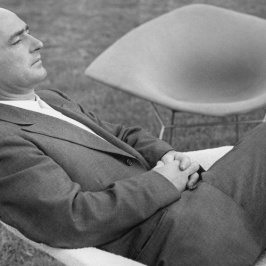
Harry Bertoia (1915-1978) stood as a versatile and gifted artist, with Knoll historian Brian Lutz noting that Bertoia’s paintings outshone his sculptures, which in turn surpassed his furniture creations—yet all were marked by brilliance.
After training at the Detroit Technical High School and the Detroit School of Arts and Crafts, Bertoia established his own metal workshop at Cranbrook, where he taught jewelry design and metalwork. His pivotal role in developing plywood lamination and bending techniques for Charles Eames’ chairs in California (1946) remains relatively uncelebrated.
Guided by Herbert Matter’s suggestion, Florence and Hans, impressed by Bertoia’s potential, enticed him to move east and set up his metal studio within Knoll’s production facility. Uniquely, they granted Bertoia the freedom to explore without demanding furniture designs, only expecting noteworthy endeavors to be shared. Bertoia’s response was nothing short of exceptional—his iconic wire furniture collection, introduced in 1952, stands as a crowning achievement of 20th-century furniture design, garnering global recognition.
Though his furniture series was singular, Bertoia’s influence persisted in Knoll’s narrative, seen in sculptures and architectural installations for Planning Unit projects, including an altar for the MIT Chapel by Eero Saarinen. Bertoia spent the next 25 years delving into light, sound, and volume through sculptures, paintings, and architectural endeavors.
Today, Knoll continues to honor Bertoia’s legacy with the ongoing production of the Bertoia collection, which has achieved worldwide acclaim since its introduction. In 2005, Knoll introduced the previously unrealized Asymmetric Lounge, showcasing Bertoia’s pioneering experimental designs.